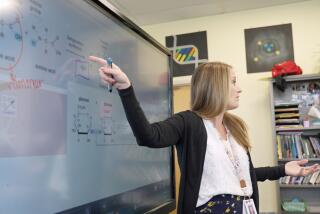Staying After School to Build Computer Literacy
- Share via
They can create funky pie charts and bar graphs, whip up office memos--and all while breezing over the keyboard at 70 words per minute.
They type with all the speed of experienced government employees, but their small hands and boundless energy are sure-fire giveaways to their ages. They are children.
If this were a job fair, it would be the perfect place to recruit a temp. But for students in the Mary Lee Geter Educational Foundation Computer Academy at Wilson Elementary in Lynwood, a future in the dot-com world may be on the horizon.
At least that’s the vision of 54-year-old founder Alice Gonzalez, who, with support from her husband, the Lynwood City Council and the school board, launched the academy as an after-school program in 1998.
Her mission was twofold: improve computer literacy among the school’s predominantly African American and Latino students and provide them with the skills needed to compete in an increasingly technology-dependent world.
Gonzalez is not an educator, but as a concerned resident who had recently taken a computer class, she said the need was obvious: Many of the students had little or no exposure to computers. And the families of most could not afford one.
“I thought, ‘These kids need computer skills or they are going to be left behind.’ ”
But before the third- and fourth-graders took the plunge into the Information Age, they needed some basic skills, the first being the ability to type.
Gonzalez and her two-member staff figured that teaching the youngsters basic keyboarding would provide a foundation for computer literacy. After all, she said, the mere act of typing on a computer can reveal much for a beginner, such as what a keyboard does and how quickly a computer processes information.
“It was a good way to teach them the technology,” said Gonzalez, a firm disciplinarian who proselytizes about the benefits of technology as if it were gospel.
Educational experts say that although it sounds simplistic, teaching youngsters the basics is an important first step in computer literacy.
“Computers are a magnet to attract kids, but once the novelty wears off they need to learn some real skills,” said Larry Cuban, a professor of education at Stanford University who studies technology in schools.
He said that, like other after-school programs nationwide that expose low-income students to computers, the Lynwood academy is helping provide equal access to technology.
“A lot of people talk about the digital divide,” he said. “This is one way of closing that gap.”
On any given day at Wilson, students sit in the glow of Pentium III 500 MHz computers, drafting letters to friends or polishing PowerPoint presentations on what they want to be when they grow up.
It’s all part of their computer academy training, and they appear to execute it with all the ease of breathing.
But students can often be found with heads up, eyes glued to the monitor, fingers feverishly typing. What spurs the youngsters on is a Typing Tutor game that flashes a series of texts on the screen and rates the speed and accuracy at which students duplicate them.
When the narrow hallways of the main building are quiet, the sound of small fingers striking keyboards is all that escapes from Room 14, the computer lab where framed portraits of Cesar Chavez, Albert Einstein and Martin Luther King Jr. watch over the students’ progress.
The children spend hours engrossed in the game, as if they were at an arcade.
“It’s fun when you type and get a high score,” said 10-year-old typing wunderkind Rodney Bunkley. The game clocked him at 68 words per minute. “My best is 72,” he beamed.
When Elizabeth Vargas first started at the academy two years ago, she could type only 15 words per minute. Now she’s up to 68.
“I’m getting better at computers,” said the shy fourth-grader. Staff members “help us learn the keys and when we don’t get high scores, they say it’s OK. We try hard, though.”
It’s the kind of drive Gonzalez hoped the mix of high- and low-achieving students would discover. The children are instilled with a sense of discipline, confidence and self-respect, much of which is an outgrowth of the academy’s rules. The students must dress properly, have good attendance, behave responsibly and complete all homework before setting one finger on a keyboard.
The academy currently runs three hours a day, four days a week. Its enrollment is limited to the number of computers available: 32.
“Failure is not acceptable in the academy,” said Paul Rourman, who was principal of Wilson during the program’s early development. “It’s changing the self-esteem and image of these children. They feel very special and will do anything to be a part of the program.”
Academy officials say the students’ Stanford 9 scores and math and reading skills have improved, thanks to after-school tutoring.
But parents say they’ve seen another change. Where there was once a dearth of knowledge about computers, the students can now explain the ins and outs of how computers work. Most aspire to become computer programmers and engineers.
“He talks about becoming a computer specialist all the time,” said Lydia Perkins, Rodney’s mother.
“It’s a desire he didn’t have before.”






